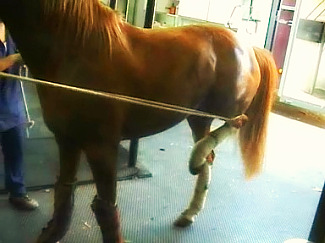Antemortem diagnosis of stringhalt, an equine neuropathy

A study conducted by researchers at the UAB confirmed for the first time, an antemortem diagnosis of the Australian stringhalt, a nerve disorder that alters the mobility of the limbs of horses. This form of stringhalt occurs when the animal ingests certain toxic plants, although in the case studied, were not found in the grass. New techniques of nerve and muscle biopsies allowed the diagnose of this neuropathy, which developed well and surprisingly fast.
Stringhalt is an abnormal gait in horses, characterized by sudden and involuntary bunny-hopping gait with severe and exaggerated flexion of 1 or both pelvic limbs during attempted movement (figure in the top left). It affects severely the motion of the horse and it even can cause loss of athletic function.
Nowadays there are two clinical presentations of stringhalt: Australian stringhalt and idiopathic stringhalt. The former has usually a sudden onset and affects both hindlimbs. Postmortem histologic studies of horses affected by Australian or acquired stringhalt have demonstrated that it corresponds to a clinical manifestation of a degenerative neuronal disease (distal axonopathy of the peroneal nerve). It has been related to ingestion of certain toxic plants present in pastures. Regarding idiopathic (also known as classic or spontaneous) it is usually unilateral and it has been reported worldwide, but there still is no information about its etiology.
A 16-year-old Westfalian gelding was presented to the Equine Teaching Hospital of the Universitat Autònoma of Barcelona for a 6-week history of a sudden, progressive bilateral abnormal gait in the pelvic limbs consistent with a form of Australian stringhalt. The horse had lived for 2 years with other unaffected horses in a pasture with no evidence of toxic plants.
In order to reach a definitive diagnosis, several specific diagnostic tools were attempted. Electromyographic examination of the pelvic limb muscles including the long digital extensor was attempted, but unfortunately the horse was extremely sensitive to any manipulation of the pelvic limbs and conclusive results could not be obtained. Biopsies from the long digital extensor muscle and the superficial peroneal nerve were obtained under general anesthesia and shipped to specialized laboratory. The final diagnosis based on histopathologic study was mixed polyneuropathy with elements of both axonal degeneration and demyelination. Surprisingly, the horse had a rapid clinical improvement which is unusual.
To the auhors’ knowledge, this is the first case of Australian stringhalt reported in Europe with a confirmed diagnosis of distal axonopathy. It is also the first case of this form of the disease diagnosed antemortem, rather than postmortem, by histological examination of nerve and muscle biopsy specimens, thus avoiding euthanasia of the patient. The technique described is new and can be performed in specialized equine hospitals. This case further demonstrates that horses can recover completely from this neuropathy.
References
"Antemortem Diagnosis of a Distal Axonopathy Causing Severe Stringhalt in a Horse". Armengou, L; Anor, S; Climent, F; Shelton, GD; Monreal, L. JOURNAL OF VETERINARY INTERNAL MEDICINE, 24 (1): 220-223 JAN-FEB 2010.


